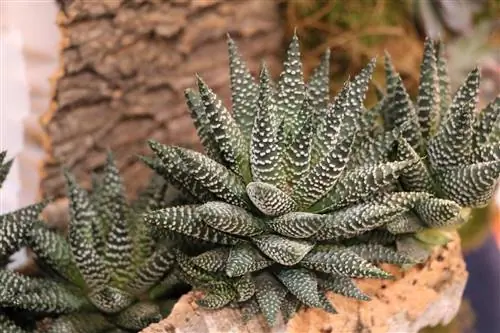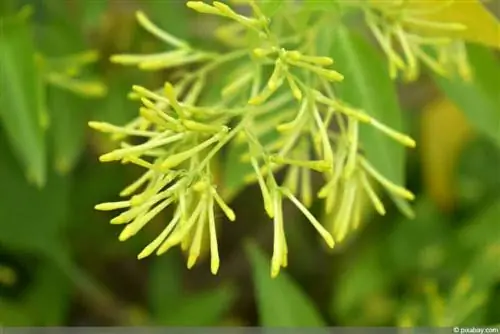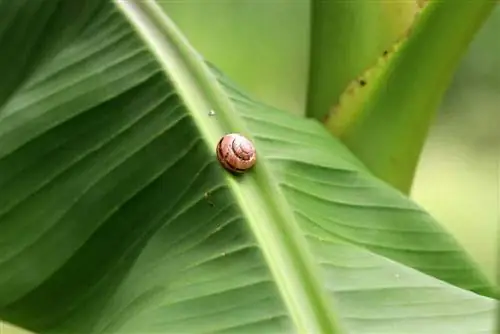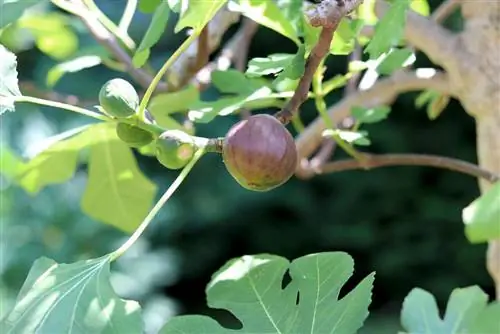- Author admin [email protected].
- Public 2023-12-17 03:39.
- Last modified 2025-01-24 12:45.
Haworthia are succulents. The plants require relatively little care; they only require small amounts of water and must not be fertilized. A simple substrate consisting of three parts compost soil and one part sharp sand is sufficient for them, and they feel quite comfortable in partial shade. Haworthia comes in very different types, but the leaves of these plants generally grow in a ring around a central stem and are thick and fleshy. They are the plants' water reservoir.
Species
Of the more than 150 species of Haworthia, not all of them are kept as houseplants. The few who really feel comfortable on the windowsill usually belong to:
- Haworthia cupsidata with its low-growing rosettes
- Haworthia margaritifera with leathery leaves bearing white warts
- Haworthia reinwardtii with trunks about 15 cm high and lanceolate, dark green leaves
- Haworthia tessellata with several almost stemless rosettes and toothed leaves
Location
Haworthia don't like full sun. Although the plants are native to Africa and tolerate heat, with little water and poor soil, they feel more comfortable in partial shade than in sunshine. The plant can tolerate the sun, but the leaves will become smaller and lose their beautiful pattern if the plants receive too much sunlight. Haworthia can be kept outdoors on the terrace as long as the temperatures do not drop below 10° C, but also feel comfortable in shallow bowls in the living room. The usual temperatures in the living room correspond entirely to your preferred environment.
Substrate and soil
The soil in the Haworthia's natural home is not particularly nutrient-rich, but rather barren. The plants do not need rich soil outdoors or in the plant pot, but do very well with a mixture of around 3 parts compost soil and one part sharp sand. The compost soil should be coarse and loose. Haworthia are shallow-rooted, they need a lot of space around them, but not too deep pots. Modern plant bowls are therefore very suitable for holding the plants, as long as they offer enough space.
Tip:
Haworthia don't like rich soils, but rather sandy, mineral soils.
Pumice gravel, lava grit and coarse sand are great for providing the plants with a natural environment. In modern, shallow bowls it looks incredibly good when the substrate beneath the plants is completely covered with a light but coarse sand. The barren surface forms a charming contrast to the rich pattern of the fleshy leaves of these plants, so that the plant bowls look like a small world of wonder.
Frequently asked questions
What happens to the dead leaves when repotting?
The dead leaves of the plants can of course be removed when repotting. However, older leaves should not be removed immediately if they appear wrinkled and discolored. The plants still get moisture and nutrients from the old leaves, which they need to build new leaves. Only completely dry, dead leaves may be removed.
Are there pests that affect Haworthia?
Yes, there are. However, aphids and scale insects rarely attack, and when they do, they are very difficult to detect. The small parasites live between the leaves in the rosette of the succulent and are difficult to find. They are fought with the usual means.
What you should know about Haworthia in brief
- The genus Haworthia includes about 150 plant species. They belong to the Asphodilla family. The genus Gasteria is also included.
- Most haworthias form rosettes of leaves, but some form pairs of leaves arranged in parallel.
- The flowers are either whitish or pale pink. The plants can bloom almost at any time of the year.
- All haworthias like light, but also cope very well with partial shade. However, they cannot tolerate direct sun at all.
- The plants are well suited for indoor living. Room temperatures should be between 5 and 15 °C in winter.
- In summer, haworthias can easily be grown outdoors if they are protected from the midday sun and rain.
- A mixture of three parts loose, coarse compost soil and one part sharp sand is suitable as a plant substrate.
Planters
- Shallow containers are suitable as planters. The root system spreads flat.
- Repotting is best done annually after the rest phase, at the beginning of the growing season.
- If the container is not yet completely overgrown, just replace the plant substrate.
- Otherwise, choose a slightly larger vessel.
Irrigation
- The Haworthia does not need much water. You water regularly during the main growing season, but not often and not much.
- Always allow the top layer of soil to dry thoroughly between two waterings.
- In winter, during the dormant period, you water very rarely, about every 4 to 5 weeks.
- You only water enough so that the soil doesn't dry out completely. It's better not to fertilize.
Propagation
- The easiest way to propagate Haworthia is via cuttings. In the summer you simply remove the side sprouts.
- The offshoots have often already developed roots and can be replanted straight away.
- For side shoots without roots, you first have to let the interface dry properly.
- This takes about two to three days. Then you press the interface into the plant substrate.
- The plants root quickly and easily.
- By the way: You can also grow haworthias from seeds. However, hybrids often form.






